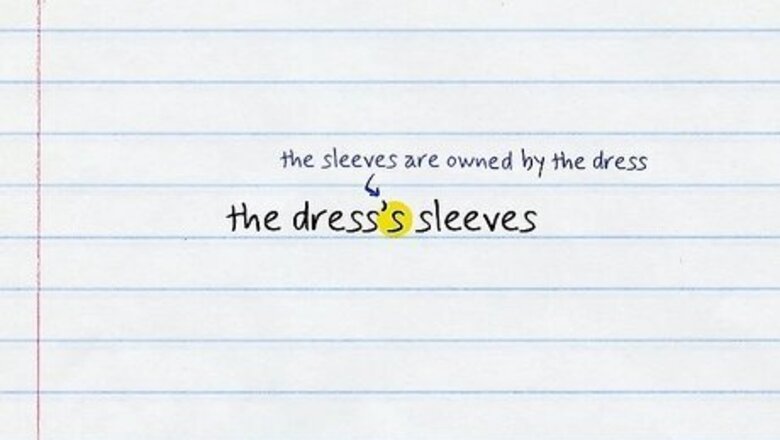
views
Using Apostrophes to Show Possession
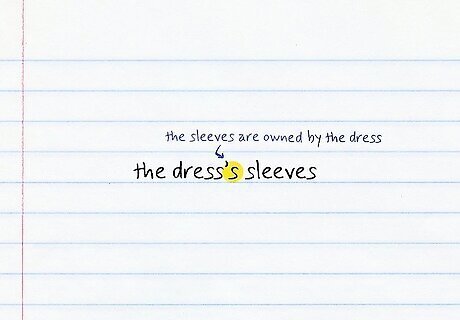
Add an apostrophe and an S to make nouns possessive. To show that a person, place, or thing owns something, add an apostrophe and the letter S to the end of the word. This applies to most singular nouns, as well as plural nouns that don’t already end in S. If a singular noun ends in S, you’ll still add another S after the apostrophe. Ex: the dog’s toy Ex: the children’s room Ex: the tree’s branch Ex: the dress’s sleeves
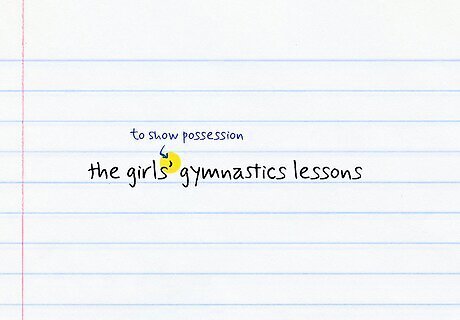
Add an apostrophe to the end of plural nouns to show possession. Most plural nouns already end in an S, so it isn’t necessary to add another S after the apostrophe. Write the plural noun as you normally would and add an apostrophe to the very end to show possession. Ex: the students’ books Ex: the houses’ roofs Ex: the girls’ gymnastics lessons
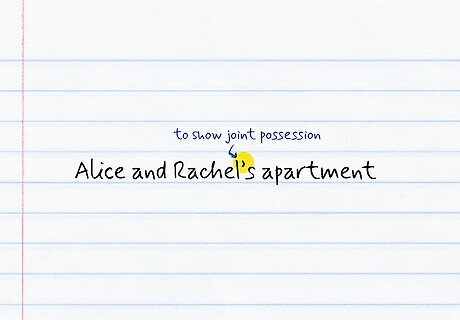
Add an apostrophe and an S to the end of a group of nouns to show joint possession. If a group of nouns all own the same thing, only add an apostrophe and the letter S to the end of the last noun in a group. This applies to a group of two or more. Ex: Jeff, Amy, and Frank’s parents Ex: Alice and Rachel’s apartment Ex: Mike and Robin’s cat
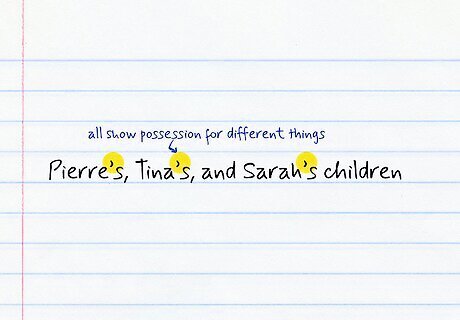
Make each noun in a group possessive if they own different things. If you have a group of nouns that all show possession for different things, add an apostrophe and the letter S to each individual noun. Ex: Lily’s and Nick’s stores Ex: Pierre’s, Tina’s, and Sarah’s children Ex: Dana’s and Valerie’s jobs
Using Apostrophes in Contractions
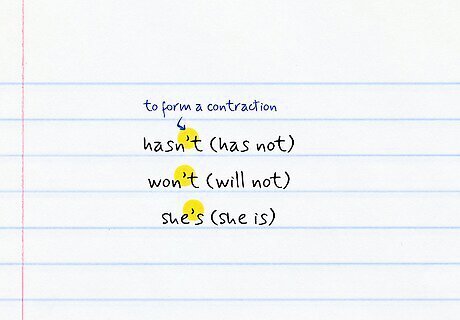
Add an apostrophe in place of missing letters to form a contraction. A contraction is a shortened form of a word or group of words that omits certain letters or sounds. In this case, the apostrophe represents those missing letters. In many cases, contractions are made up of a noun or pronoun and a verb or helping verb. Ex: hasn’t (has not) Ex: won’t (will not) Ex: she’s (she is) Avoid using contractions that don’t exist, like “shouldn’t’ve.” We often say these in real life, but they aren’t appropriate for formal writing. Be very careful with the word “it.” Use an apostrophe with the word “it” only when you want to indicate a contraction for “it is” or “it has.” “It” is a pronoun, and pronouns have their own possessive form that does not use an apostrophe.
Adding Apostrophes After ‘S’

Add an apostrophe after a plural noun that ends in S. If a plural noun already ends in S, add an apostrophe after the S to make the word possessive. Because that S is already there, there is no need to add another one after the apostrophe. Ex: schools becomes schools’ Ex: dolls becomes dolls’ Ex: turtles becomes turtles’
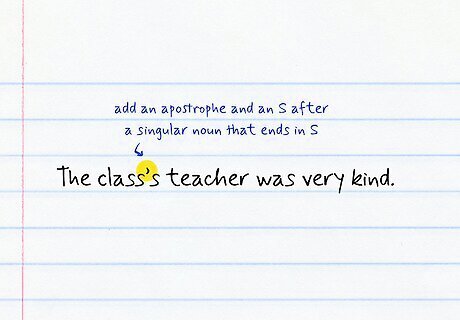
Add an apostrophe and an S after a singular noun that ends in S. Remember, if a singular noun ends with the letter S, it is still one object. Because of this, you must add an apostrophe and another S to the end to show possession. According to some style guides, it is technically okay to only add the apostrophe if it’s a proper name that ends in S, but most guides prefer adding another S at the end. Ex: the class’s Ex: Atlas’s Ex: the iris’s
Forming Plurals of Letters, Numbers, & Symbols
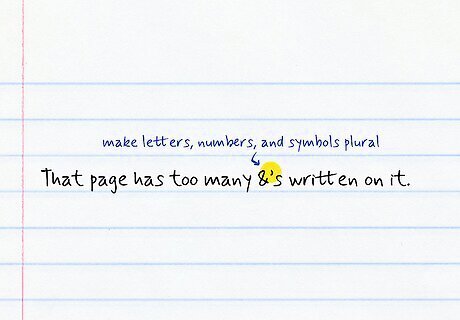
Use apostrophes to make letters, numbers, and symbols plural. While apostrophes are not used to make actual nouns or other words plural, they are used to create plural forms of individual letters, numbers, and other symbols, like ampersands. In most cases, simply add an apostrophe and an S at the end of the symbol. Ex: “I got three A’s on my report card.” Ex: “There are two 5’s in my phone number.” Ex: “That page has too many &’s written on it.” If this seems confusing for numbers, avoid the problem altogether by spelling out the word of the number, like “ones” instead of “1’s.” Only do this for numerals that are ten or lower, however.
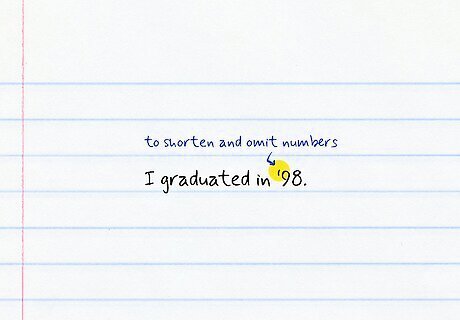
Use apostrophes to shorten and omit numbers. Similar to contractions, apostrophes can be used to omit certain numbers from a larger number. This is most often used in relation to years. Just remember that the apostrophe goes before the remaining numbers, not after. Ex: Instead of saying, “I graduated in 1998,” say “I graduated in ‘98.” Ex: Instead of writing 2007, write ‘07
Using Apostrophes with Names

Add an apostrophe and an S to the end of a name to show possession. To make someone’s name or other proper noun possessive, add an apostrophe and an S to the end of the name. This applies to all singular names, including those that end with an S, like James. If the name is plural, like when referring to a family’s last name, add only an apostrophe. Ex: Mary’s cat Ex: China’s foreign policy Ex: Miles’s book Depending on the style guide you follow, it may be appropriate to add only an apostrophe after a name that ends with ‘s’ (ex: James’). Most style guides prefer adding an apostrophe ‘s,’ however (ex: James’s). If you’re referring to an entire family showing possession, make the name plural first. For example, the last name “Jones” would become “Joneses’”
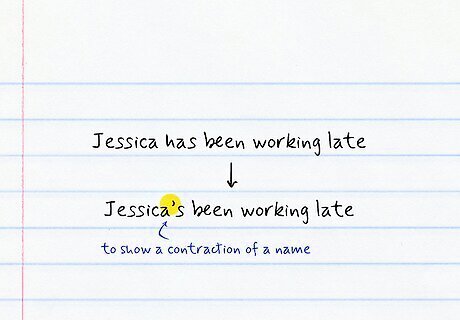
Add an apostrophe and an S to show a contraction of a name. Just as apostrophes are used to form contractions with pronouns and verbs, they can also be used to form contractions with names and other proper nouns. Add the apostrophe after the name and in place of the words or sounds you’re omitting. For example, instead of writing “Ben is coming,” you’d write “Ben’s coming.” Instead of saying “Jessica has been working late,” you’d say “Jessica’s been working late.” Instead of saying “Greg is really funny,” you’d say “Greg’s really funny.” Technically, it isn’t grammatically correct to form a contraction using a proper name, as adding an apostrophe ‘s’ is supposed to indicate possession. While this should be avoided in formal writing, it’s generally okay to use in informal writing or in conversation.
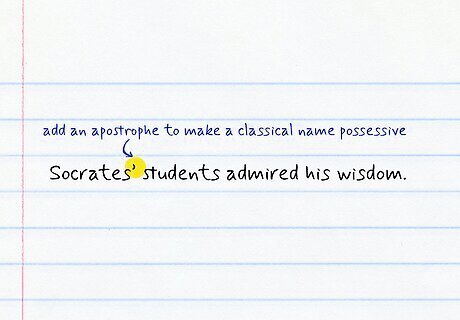
Add only an apostrophe after a classical name ending in S. According to some style guides, classical and Biblical names have their own conventions when it comes to apostrophes. If the name ends in S and has two or more syllables, only add an apostrophe to make it possessive. If it ends in an S and is only one syllable, add an apostrophe ‘s.’ Ex: Jesus’ disciples Ex: Zeus’s warning Ex: Socrates’ students
When Not to Use an Apostrophe

Do not use apostrophes with possessive pronouns. In general, apostrophes are the standard way to show possession, but this does not apply to pronouns. In some cases, adding an apostrophe to a pronoun would make it a contraction instead, like with the pronoun “it.” For example, “his,” “hers,” “its,” “yours,” “my,” and “ours,” are all possessive pronouns. None of them require an apostrophe to show possession. Adding an apostrophe to “it,” would make the word “it’s,” which is a contraction of “it is.”
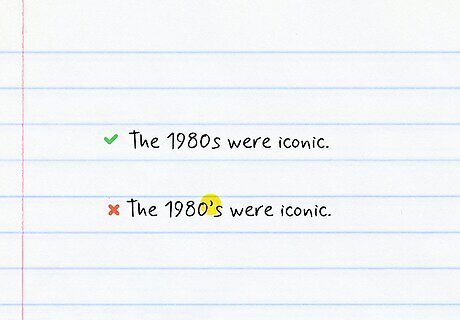
Do not use apostrophes to make words plural. If you’re trying to make a word plural, simply add the usual suffix, like ‘s’ or ‘es.’ This includes words that already end in an S, as adding an apostrophe would make them possessive rather than plural. Ex: the plural of the last name “Johnson” is “Johnsons,” not “Johnson’s” Ex: If you have more than one apple, write “apples,” not “apple’s.” This includes acronyms, like “CD.” The plural form of CD is “CDs,” not “CD’s.” To make a year plural, like 1980, write “1980s” not “1980’s.” The wrong use of an apostrophe to form the plural is called the greengrocer's apostrophe since grocers are often the worst (or at least the most visible) offenders.
Writing Apostrophes with Other Punctuation

Do not separate the apostrophe from its word. An apostrophe is part of the word it belongs to, so do not separate it from that word with other forms of punctuation, like periods, commas, or quotation marks. Ex: Write Can I ask you somethin’? rather than Can I ask you somethin?’ Ex: Write “‘Twas the night before Christmas,” he said, rather than ’“Twas the night before Christmas,” he said.
Writing Apostrophes in Cursive

Connect all letters of the word before adding an apostrophe. When writing in cursive, write and connect all the letters of the word, including any letters that are usually separated by an apostrophe. Then, add the apostrophe in its usual spot. Example: If you’re writing the word “she’s,” first write “shes” and then add the apostrophe between the E and the S.











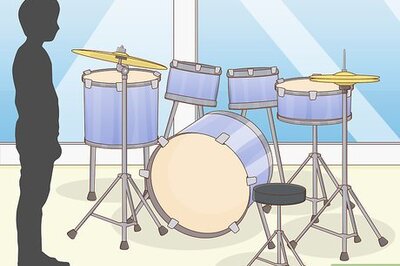



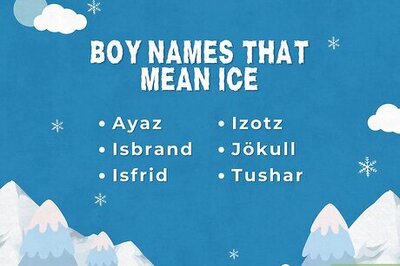


Comments
0 comment